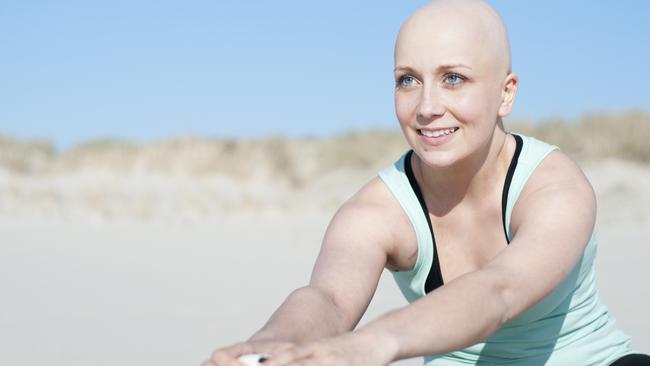How medical breakthroughs have slashed the cancer death rate
Some doctors now speak of cancer becoming a chronic illness rather than a death sentence. This is what doctors have found and how it will change the way patients are treated.
Illness
Don't miss out on the headlines from Illness. Followed categories will be added to My News.
More than a million Australians are living with cancer, but the death rate from the disease has plunged in the last decade thanks to major medical breakthroughs.
Better screening programs, a massive drop in smoking rates and the introduction of the cervical cancer vaccine are preventing cancer in the first place or catching it earlier when it can be successfully treated.
The death rate (number of deaths per 100,000 people) from cancer has tumbled by more than 24 per cent since the 1980s when half those with a cancer diagnosis died within five years.
Today, almost 7 in 10 Australians will survive for at least 5 years and some cancers have a survival rate as high as 90 per cent.
A new study of 3.7 million cancer cases worldwide found Australia had the best five year cancer survival rate in the world.
About 150,000 people each year.
Some doctors now speak of the disease becoming a chronic illness rather than a death sentence.
While one in every two Australians can expect a cancer diagnosis by the age of 85, the rate of cancer diagnoses is falling.
Cancer diagnoses peaked at 508 cases per 100,000 people in 2008 and dropped to 483 cases per 100,000 people in 2019 according to the Australian Institute of Health and Welfare.
Here we take you through the medical breakthroughs of the last decade that have helped save and extend the lives of cancer patients.

KILLING OFF CERVICAL CANCER
Cancer Council CEO Professor Sanchia Aranda lists the new 2017 cervical cancer screening program and the cervical cancer vaccine among the biggest advances of the decade.
Last year researchers revealed Australia is on track to be the first country in the world to eliminate cervical cancer as a result of a nationwide free vaccination program for male and female teenagers.
Combined with a more sensitive cervical cancer test, introduced in 2017, “this has put Australian on track to eliminate cervical cancer as a public health issue by 2035,” Professor Aranda said.
IMMUNOTHERAPIES
Professor David Thomas, the Director of The Kinghorn Cancer Centre and Head of the Cancer Theme of the Garvan Institute, rates immunotherapies as the major breakthrough of the decade.
Immunotherapies like Yervoy, Keytruda and Opdivo harnesses the body’s natural immune system to fight cancer and “the immune system in some people continues to fight the cancer even when the drug is withdrawn” he said.
Previously only five per cent of people with advanced incurable cancer lived longer than five years. With immunotherapy that has risen to 20 to 30 per cent of patients.
“It’s proving to be scarily like a cure, I wouldn’t say it’s a cure yet but the durability of the benefit is much longer,” he said.
The head of Peter MacCallum Cancer Centre’s molecular oncology laboratory Preofessor Grant McArthur said immunpotherapies had “totally changed the way we think about cancers”. “They trick the ummune system and this enables the cancer to survive,” he said.

CAR-T CELL THERAPIES
Another amazing breakthrough has been CAR-T cell therapy which combines immunotherapy with genetic engineering.
Scientists harvest T cells (a type of white blood cell that is an important part of the immune system) from people, genetically alter them, then infuse the resulting CAR-T cells into patients so they recognise and attack their tumours.
“Children dying of leukaemia have had Lazarus-like recoveries … but while it’s worked well for blood cancers the translation into solid malignancies in adults is proving difficult,” Professor Thomas said.
In Australia the CAR-T cell therapy Kymriah is approved for the treatment of relapsed or refractory patients with paediatric B-cell acute lymphoblastic leukaemia (ALL) and adult diffuse large B-cell lymphoma (DLBCL).
PRECISION MEDICINE THAT FINGERPRINTS CANCER
Professor Thomas has been working on another breakthrough in cancer treatment-precision medicine which involves testing the genome of tumours and finding targeted therapies to beat the cancer.
In half the patients with cancer of unknown origin the Garvan Institute has found molecular targets for medication but finding a drug trial patients can use is more difficult.
Those who can’t find a suitable trial are offered immunotherapy and Professor Thomas said a promising subset of these patients have survived longer than expected.
BLOOD TESTS FOR CANCER
The holy grail of cancer detection and treatment is a blood test that can pick it up before it becomes life threatening and major advances have been made towards this goal.
In November 2019 researchers at the University of Nottingham in the UK reported they had developed a blood test that could detect breast cancer up to five years before there are any clinical signs but its only 37 per cent accurate.
Another blood test developed by GRAIL probes DNA for tiny chemical tags (methylation) which cancer cells shed into the bloodstream when they die it is 99.4 per cent accurate on 20 types of cancer.
Toshiba and Tokyo University have invented a technology that can diagnose 13 types of cancer with 99 per cent accuracy from a single drop of blood in a matter of hours.

ARTIFICIAL INTELLIGENCE DETECTING CANCER
In the last decade computers have been trained to diagnose skin cancers from pixel level information in pictures and proved better at doing so than 21 board certified dermatologists.
A recent Northwestern University study found artificial intelligence can outperform radiologists at cancer screening, especially in patients with lung cancer cutting false positive rates by 11 per cent.
USING VIRUSES TO KILL CANCER
Scientists are exploring whether viruses could be used to kill cancer by prompting the immune system to recognise and fight the cancer.
A new virus based on cowpox has killed almost every known type of cancer cell in a petrie dish.
US scientists have turned the virus that causes the common cold into a treatment to kill brain cancer — in some patients the cancer disappeared for years before returning, in others it shrank the tumours considerably.
A modified form of the herpes or cold sore virus called Imlygic or T-Vec is being used to treat melanoma. It helps the body’s immune system recognise and destroy tumours and then finds other melanoma cells throughout the body and kills them.
Australian Researcher Associate professor Tom John from the Olivia Newton John Cancer Research Institute recently tested another virus treatment in combination with immunotherapy (Keytruda) on 11 lung cancer patients and three patients saw their tumours shrink.
USING LIGHT TO KILL CANCER
Dr Andrew Stephens, from the Hudson Institute of Medical Research in Melbourne is trialling a treatment that uses light and a modified form of chlorophyll from plants to kill cancer.
The chemical has been turned into a gel, which is being tested on patients with basal cell carcinoma skin cancers, it is also being turned into an intravenous formulation to see if it can treat ovarian, lung and prostate cancers.
When the patient is exposed to light beams of a certain wavelength, the photosensitiser becomes toxic to the cancer cells. Unlike previous such treatments, this one does not require patients to be locked in a darkened room for weeks or months after treatment.

MORE NEWS
Immunotherapy saves a 101 year old
GROWING TUMOURS ON MICE TO FIND PERSONALISED THERAPIES
A breakthrough new way to find personalised treatments for hard-to-treat cancers is seeing researchers take samples of human tumours and grow them on mice so they can test possible therapies on the mice.
A team from the Children’s Cancer Institute in Sydney used the method to test a new drug CBL0137 on a ferocious form of the blood cancer that kills half the infants who contract it, became undetectable in mice treated with chemotherapy and the new drug.
MOPPING UP CANCER CELLS THAT SURVIVE TREATMENT
A breakthrough new treatment for ovarian cancer that aims to stop the disease returning by killing off the cancer’s stem cells is undergoing safety trials in Australia.
Cantrixil targets certain cancer stem cells that are not destroyed during initial chemotherapy treatment.
THE NEXT DECADE
Professor Thomas said the next decade of cancer breakthroughs would include finding ways of picking up cancer earlier through better screening, using immunotherapies on people at high risk of cancer before they develop it in the hope of preventing it, and combining therapies to achieve a better therapeutic outcome.
Professor McArthur said the next deacde of cancer breakthroughs would be funding ways to make immunotherapies work in all patients.
“Only 20 per cent of patients are getting really significant benefits from immunotherapies, we need to know why all cancer patients don’t respond and there is a huge effort to discover that,” he said.
